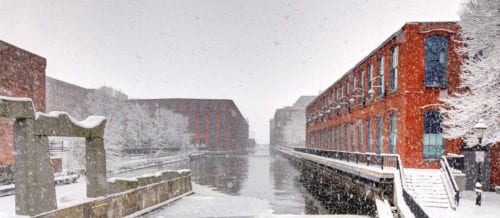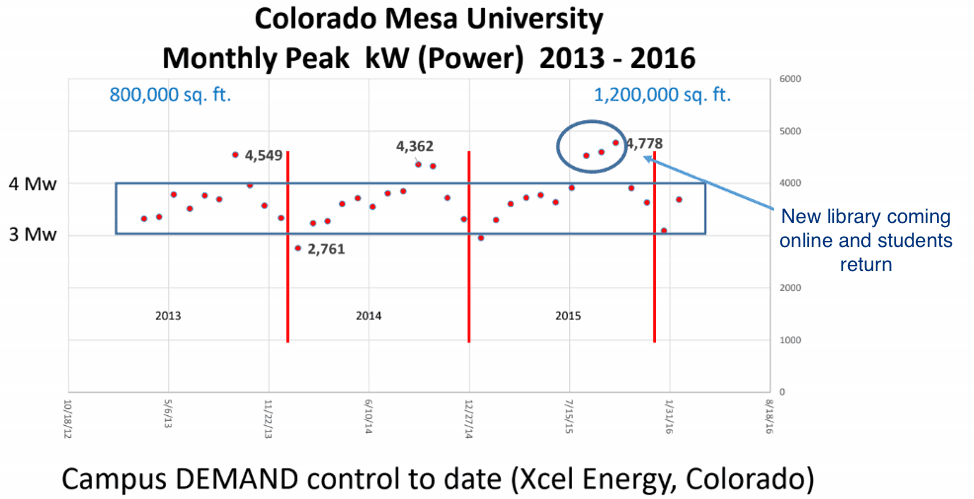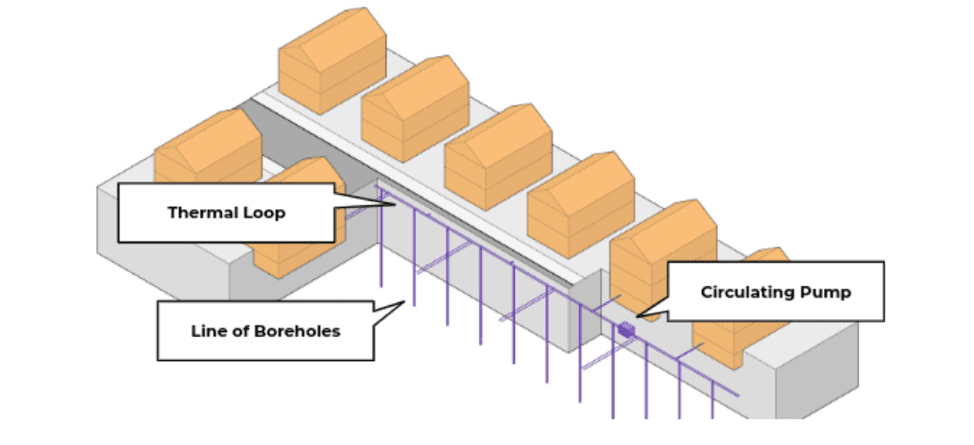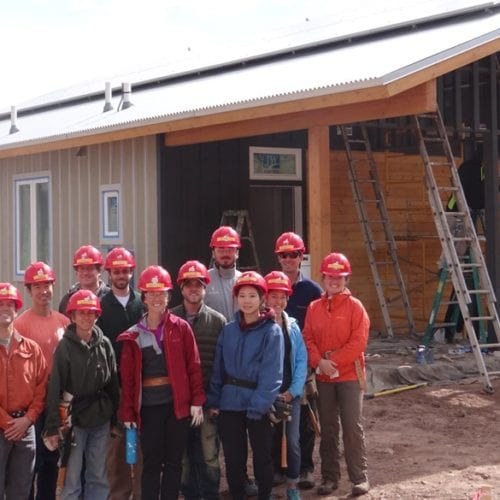Blizzard conditions in Lowell, Massachusetts. Lowell is known as the cradle of the industrial revolution in the United States and many of the city's historic sites have been preserved by the National Park Service. Lowell is a vibrant city with a thriving arts scene, cobblestone streets, and a bustling downtown

Pipes or Wires?
This article is a guest posting by Audrey Schulman, co-executive director of HEET in Massachusetts. Audrey championed the Energy Shift Pilot Project, a project team at e–Lab Accelerator 2019. After the 2018 explosions in the Merrimack Valley, it has become a community priority to replace gas with other viable heating sources in Massachusetts. Audrey’s team explored the business viability of transitioning communities to utility-owned and -operated renewable geothermal district systems. The detailed implementation plans advanced significantly while the team was at Accelerator, and HEET is currently working with utilities on multiple pilot project proposals. Audrey shares the source of inspiration for their innovative approach in this article.
We want to embrace a vision of a future where all the energy for our buildings comes from renewables. We imagine vast fields of solar panels and wind turbines glittering in the sun, all our energy delivered through wires, our electric companies transforming into renewable electricity companies.
Implicit in this vision is the prospect that all the companies selling gas today will no longer have customers to sell to. Focused on fighting climate change, we try not to imagine the unemployed workers and stranded assets that would go along with gas companies going out of business.
But perhaps there’s an alternative. Perhaps some of the renewable energy we need could come through pipes. Perhaps, gas companies could also transform, becoming renewable thermal companies, and pipes could compete with wires to bring customers renewable energy at a lower cost.
One potential way this could be done has been demonstrated at Colorado Mesa University. There, renewable energy has been delivered through pipes, heating and cooling the buildings for almost a decade, demonstrating huge savings in emissions, money, and water.
Colorado Mesa University is located in Grand Junction, where the temperature ranges from 20 to 100 degrees Fahrenheit. Heating large buildings can be expensive, but cooling them can cost even more because it uses both electricity and water (excess heat is removed through water evaporation in cooling towers). According to the US Environmental Protection Agency’s WaterSense at Work report, cooling towers typically use 20–50 percent of a facility’s total water use in institutional and commercial buildings.
The Original Plan
In an attempt to defray those energy and water costs, back in 2006, when the university consisted of just a few buildings and 2,500 students, the administration decided to install a geothermal array to heat and cool a new classroom building.
Water pumped through this borehole array would absorb the earth’s constant temperature and then be pumped up to a heat exchanger in the building. If the building needed heat, the exchanger would extract heat from the water as it was pumped by, returning the water colder than before. If instead the building needed cooling, it would return the water hotter. Either way, that water’s temperature would be restored as it was pumped back through the boreholes, allowing for more energy to be pulled off day after day.
GreyEdge Group’s partner Sound Geothermal (SGT) won the bid to design and install the borehole array and system. However, as the company started the work, the geo-design engineer, Cary Smith, learned that the campus had another seven new buildings planned. He sat down with the facilities department and university president to pitch an unusual idea. He pointed out that on days where the weather was cold, the labs and dormitories had the heat cranking, while a few crowded classroom buildings were using air conditioning. Paying for heating and cooling at the same time was a waste.
Sharing Energy
Smith proposed instead to have all the buildings on campus pull their heating and cooling needs off a single shared loop of water. The loop (an 18” diameter pipe buried three feet underground) would carry ambient-temperature water from building to building. If the university installed this type of loop, the crowded classrooms using air conditioning would extract heat from the building and send it to the loop, returning the water into the loop hotter. The labs and dormitories requiring heat could harvest that heat. Wasted energy would be turned into usable energy.
The rest of the energy needs would be provided by geothermal, through the boreholes that were already being installed. The mechanical rooms needed in each building would be smaller and less expensive than a conventional HVAC system, freeing up building space and money.
During the summer, when all the buildings need cooling, that cooling could be delivered at a much lower cost, because even when the air outside is 100 degrees, the ground is still only 57 degrees. The excess heat could be stored in the water in the shared loop and then released through the cooling towers at night when the air temperature is 75 degrees instead of 100. Not only does it take less electricity to release the heat then, it also spreads out the electricity use more evenly, reducing the site’s monthly peak use and thus its demand charges. (A demand charge is a charge on commercial electricity bills for reserving system capacity to meet the customer’s highest hour of electricity use per month. Demand charges tend to be a significant portion of any commercial energy bill.)
Perhaps the clincher was that Smith pointed out that there was a state incentive that would help pay for the central loop.

The university administration agreed, and the shared loop was installed with the capacity to expand in any direction. This capacity for expansion was needed quickly, because the square footage of the university buildings, as well as the number of students enrolled, quadrupled over the next decade.
As different buildings were added to the ground loop, each with their different energy patterns, the borehole array moved from being just a source of energy to also being a battery that could store enough unused thermal energy in the ground to heat or cool the buildings for four days. (Given a system design limit of 10 percent temperature variation, this is equivalent to 8,000 heating tons.)
Savings of Money, Water, and Emissions
Over time, as more cooling was needed by the campus buildings than heating, an excess of heat built up in the shared loop and the borehole array. A long-term temperature imbalance can erode the system’s efficiency over time, so SGT’s geo-design team and Colorado Mesa University solved the problem by designing a method to dump the extra heat into the irrigation water for the lawns. Once the method is implemented, the water will get pre-warmed to 85 degrees to keep the lawns greener for longer in the fall and spring. Green grass seems like a nice side effect of air conditioning.
This shared-loop geothermal system requires only one-third of the water and a quarter of the energy that would be required per square foot by a more conventional combination of natural gas boilers and cooling towers. Including demand charges, the system saves $1 million per year in energy bills alone, supplying 100 percent of the heating and 79 percent of the cooling energy for all connected buildings (with the rest of the cooling met by much fewer cooling towers).
Iterate with Financing
GreyEdge has installed the same type of shared-loop geothermal in Utah at Weber State University. To reach the university’s goal of being carbon neutral by 2050, the university created a $5 million investment fund and reinvested 100 percent of the energy savings money into further work. This fund ensures that the work isn’t slowed by having to fundraise for each new building, which allows the university to retrofit the buildings and install the loop even faster, saving energy and money at a faster rate.
Increasing Scale, Increasing Impact
Both universities have cut their fossil fuel emissions from heating and cooling by 75 percent, but the data from both sites has shown that as the number of buildings connected to each shared loop increased and the energy use got more diverse, the percentage of savings from efficiency got bigger. Imagine for a minute what might be possible on a citywide scale.
Reliable and Resilient
Which brings us back to gas companies. Could they possibly transition to this type of shared-loop geothermal to deliver renewable cooling and heating through pipes? Instead of fossil fuel pipes running under the street, picture a borehole array connected to a shared loop of water under the street, with service lines extending off to the sides to homes and hockey rinks, data centers and assisted living homes. The underground system, dependent on water rather than explosive gas, would be safer. Being underground and composed of interconnected shared loops with redundant pump stations would be more reliable and resilient during weather extremes. And the larger the system, the more diverse the energy needs, and the more efficient the system.
HEET, an energy efficiency nonprofit, is working with gas companies and regulators toward such a pilot project in Massachusetts. HEET’s RMI e–Lab team included a geothermal expert form GreyEdge, an engineer from BuroHappold, the co-leader of the Gas Leaks Allies (a coalition of nonprofits and researchers), and an infrastructure ecologist from Boston University. Aside from bonding as a group and developing the idea, e–Lab allowed the group to learn from the faculty members and pitch the concept to the attending utilities to fine-tune their concepts. Currently, HEET is talking with five utilities about piloting the concept. Both Eversource in Massachusetts and Con Ed in New York have submitted proposals to their respective state regulators proposing multiple pilots.

Image courtesy of BuroHappold Engineering
The Netherlands passed a law in 2018 that all municipalities must file plans to get off natural gas. Berkeley, California, passed an ordinance last year against installing gas in any new development, and many other areas, like Westchester County, New York, and Western Massachusetts, have moratoriums on new gas services because not enough gas can be piped in. The need to come up with renewable alternatives to gas is a pressing one.
Perhaps this is the time for gas companies to explore a new business model, one with a promising future for both the companies and the planet. A business model where the companies deliver renewable heating and cooling to homes and businesses along every street, allowing customers a choice in our renewables from both wires and pipes.
More information about HEET’s pilot project can be found online at https://heetma.org/energyshift/.
Background about the project and their work at e–Lab Accelerator is available at https://rmi.org/elab-2019-energy-shift-pilot-project.

